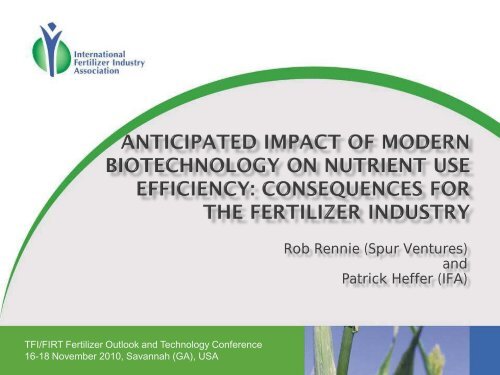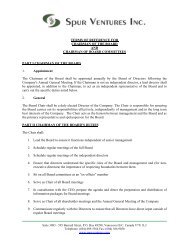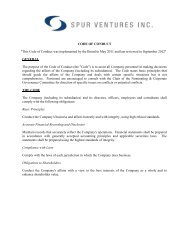Biotechnology: A Modern Tool for Food Production Improvement
Biotechnology: A Modern Tool for Food Production Improvement
Biotechnology: A Modern Tool for Food Production Improvement
You also want an ePaper? Increase the reach of your titles
YUMPU automatically turns print PDFs into web optimized ePapers that Google loves.
TFI/FIRT Fertilizer Outlook and Technology Conference<br />
16-18 November 2010, Savannah (GA), USA<br />
Rob Rennie (Spur Ventures)<br />
and<br />
Patrick Heffer (IFA)
Source: ISAAA<br />
+ 7%
y country by crop by trait<br />
• USA: 64.0<br />
• Brazil: 21.4<br />
• Argentina: 21.3<br />
• India: 8.4<br />
• Canada: 8.2<br />
• China: 3.7<br />
• Paraguay: 2.2<br />
• South Africa: 2.1<br />
• ROW: ~ 2.7<br />
• Soybean: 69.2<br />
(77%)<br />
• Maize: 41.7<br />
(26%)<br />
• Cotton: 16.1<br />
(49%)<br />
• Rapeseed: 6.4<br />
(21%)<br />
• Others: ~ 0.6<br />
• Herbicide tolerance (HT): 83.6<br />
• Insect resistance (IR): 21.7<br />
• HT + IR: 28.7<br />
• Others: < 0.1<br />
Current traits have little<br />
impact on fertilizer<br />
consumption<br />
Source: ISAAA
• Drought tolerance<br />
expected commercial release of the first maize varieties in 2011<br />
• Increased yield<br />
• Resistance to additional pests<br />
e.g. resistance to anthracnose, aphids, nematodes<br />
• Nitrogen use efficiency<br />
• Output traits<br />
o<br />
o<br />
o<br />
Remedy to deficiencies<br />
higher vitamin and iron content<br />
Improved nutritional profile<br />
improved amino acid and fatty acid<br />
composition<br />
Improved processing properties<br />
ethanol value, modified starch, higher solid<br />
content, improved fiber quality<br />
Courtesy of Syngenta
• Improved yield<br />
higher nutrient requirements<br />
• Improved yield stability (e.g. crop health, drought tolerance)<br />
greater incentives <strong>for</strong> investing in inputs<br />
• Adaptation to unfavourable conditions (e.g. tolerance to drought,<br />
salinity, flood, acidic soils)<br />
additional area to be fertilized<br />
• Improved nutrient use efficiency (nutrient<br />
uptake, translocation, metabolism or storage)<br />
lower requirements per unit output<br />
• Varieties with new traits<br />
specific requirements to optimize<br />
expression of the traits<br />
Courtesy of Monsanto
• Low average nitrogen use efficiency in field conditions<br />
global average: ~40% recovery in the year of application<br />
…but >80% can be achieved in experimental conditions<br />
significant potential gain<br />
• Different scenarios between developed and developing countries<br />
Evolution of nitrogen use efficiency of maize in the USA (left) and cereals, oilseeds and potatoes in<br />
China (right), measured as partial factor productivity (kg harvested product / kg N applied)<br />
Source: IFA
• Other major seed companies<br />
e.g. Limagrain/Vilmorin<br />
• Start-ups<br />
o Arcadia Biosciences (JVs with Pioneer, Monsanto , Vilmorin)<br />
o Evogene (JV with Monsanto)<br />
• Public research<br />
several agronomic research institutes and universities<br />
• … but some have discontinued their research<br />
e.g. CIMMYT<br />
Main target crops:<br />
• maize<br />
• … but also rapeseed, wheat, rice, etc.
• Nitrogen use efficiency in plants is a complex trait that depends on a<br />
number of internal and external factors<br />
• The molecular basis <strong>for</strong> organism-wide regulation of nitrate<br />
assimilation is not yet fully understood<br />
• Nitrogen use efficiency has been already indirectly improved by<br />
nature and through ‘conventional’ breeding<br />
• Genetic variability in nitrogen use efficiency has been reported in<br />
many crops: maize, wheat, rapeseed, etc.<br />
• Several options <strong>for</strong> genetically improving nitrogen<br />
use efficiency:<br />
o Increase water use efficiency (WUE)<br />
o Increase uptake efficiency (e.g. overexpression<br />
o<br />
of transporters)<br />
Increase physiological use efficiency (e.g. overexpression<br />
of nitrate reductase, glutamine<br />
synthetase, alanine amino transferase)<br />
• Biotechnological interventions to improve crop<br />
nitrogen use efficiency have met with limited<br />
success so far<br />
Courtesy of Syngenta
Location of QTLs <strong>for</strong> physiological traits associated with N use efficiency in maize (Gallais and Hirel, 2003)
Nitrogen-Utilization Corn Tested by<br />
Monsanto<br />
Nitrogen Efficient Rapeseed Tested by<br />
Arcadia Biosciences<br />
4400<br />
4000<br />
Transgenic<br />
Control<br />
3600<br />
Seed yield [lb/ac]<br />
3200<br />
2800<br />
2400<br />
2000<br />
1600<br />
1200<br />
0 50 100 150 200 250<br />
Nitrogen application level [lb N/ac]<br />
All companies are still at the ‘proof-of-concept’ stage<br />
Commercial release unlikely be<strong>for</strong>e 2015 (rapeseed), if not 2020 (maize)
Credit: Dupont Pioneer<br />
Credit: Arcadia Biosciences<br />
Genetically modified Arabidopsis plants<br />
over expressing a NUE candidate gene<br />
remain green when grown under limiting<br />
nitrogen conditions (left), while non<br />
transgenic plants (control) display signs of<br />
nitrogen starvation (right)<br />
Credit: Evogene
Likely impact of research investment in increasing<br />
nitrogen use efficiency (Giller et al., 2004)<br />
In the short and medium<br />
term, most of the gain in<br />
nitrogen use efficiency is<br />
expected to come from<br />
improved agronomic<br />
practices<br />
<strong>Biotechnology</strong> is seen<br />
contributing only in the<br />
long term, and relatively<br />
modestly (less than<br />
‘conventional’ breeding)
Examples of fertilizer best management practices:<br />
using ‘the right product at the right rate, right time and right place’<br />
Right Product(s)/<br />
Source(s)<br />
• Balanced<br />
fertilization (N, P,<br />
K, secondary and<br />
micronutrients)<br />
• Nutrient <strong>for</strong>m<br />
(urea, nitrate,<br />
ammonium)<br />
Right Rate Right Time Right Place<br />
• Soil testing<br />
• Yield goal analysis<br />
• Crop removal<br />
balance<br />
• Plant tissue analysis<br />
• Crop inspection<br />
• Record keeping<br />
• Variable-rate<br />
application<br />
technology<br />
• Application timing<br />
• Slow- and<br />
controlled-release<br />
fertilizers<br />
• Urease and<br />
nitrification<br />
inhibitors<br />
• Application<br />
method<br />
• Incorporation of<br />
fertilizer<br />
• Applicator<br />
maintenance and<br />
calibration
Nitrogen Fertilizer Use by Crop at the Global Level: 2006-2006/07<br />
No impact be<strong>for</strong>e 2020<br />
Maize and rapeseed<br />
together account <strong>for</strong>
Examples of other traits with a potential impact on fertilizer consumption<br />
Nutrient<br />
Nitrogen<br />
Phosphorus<br />
Potassium<br />
Sulphur<br />
Micronutrients<br />
All nutrients<br />
Trait<br />
Improved protein content<br />
Higher bioavailable phosphorus content<br />
Phytase-excreting plants<br />
Improved phosphorus metabolism efficiency<br />
Enhanced potassium absorption<br />
Improved content in essential amino acids<br />
Higher zinc content<br />
Higher iron content<br />
Tolerance to drought<br />
Tolerance to salinity<br />
Aluminium tolerance
• Harnessing the rhizoshpere<br />
o<br />
o<br />
o<br />
Focus on “The Hidden Half”<br />
• root health critical to nutrient and water uptake<br />
• manipulation of this ‘source sink’ is critical<br />
Plant growth-promoting rhizobacteria (PGPR)<br />
Biological control agents (BCAs)<br />
• <strong>Improvement</strong> of microorganisms and<br />
symbiosis<br />
o Phosphorus solubilization<br />
o Sulphur oxidization<br />
o Ability to develop symbiosis with<br />
nitrogen fixing bacteria<br />
o Improved nitrogen fixation in legumes<br />
Courtesy of Monsanto
• Fertilizer uptake by plants is low<br />
• low recovery rates in year of application: ~40% <strong>for</strong> nitrogen and<br />
• Several biotechnological inventions in the pipeline could<br />
have a potential impact on crop nutrition<br />
• Impact on fertilizer demand is seen either positive or<br />
negative depending on the trait<br />
• The main trait expected to have an impact on fertilizer<br />
consumption is nitrogen use efficiency, but no impact<br />
anticipated be<strong>for</strong>e 2020<br />
• Main gains in nitrogen use efficiency in the short and<br />
medium term seen coming from improved agronomic<br />
practices<br />
• In the long term, the fertilizer industry might have to<br />
compete with ‘non-traditional’ actors and should develop<br />
partnerships with them








